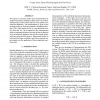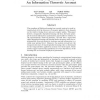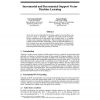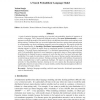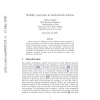NIPS
2000
14 years 27 days ago
2000
Preliminary work by the authors made use of the so-called "Manhattan world" assumption about the scene statistics of city and indoor scenes. This assumption stated that ...
NIPS
2000
14 years 27 days ago
2000
We describe a joint probabilistic model for modeling the contents and inter-connectivity of document collections such as sets of web pages or research paper archives. The model is...
NIPS
2000
14 years 27 days ago
2000
We propose a non-linear feature space transformation for speaker/environment adaptation which forces the individual dimensions of the acoustic data for every speaker to be Gaussia...
NIPS
2000
14 years 27 days ago
2000
The paradigm of Hebbian learning has recently received a novel interpretation with the discovery of synaptic plasticity that depends on the relative timing of pre and post synapti...
NIPS
2000
14 years 27 days ago
2000
The Vicinal Risk Minimization principle establishes a bridge between generative models and methods derived from the Structural Risk Minimization Principle such as Support Vector M...
NIPS
2000
14 years 27 days ago
2000
An on-line recursive algorithm for training support vector machines, one vector at a time, is presented. Adiabatic increments retain the KuhnTucker conditions on all previously se...
NIPS
2000
14 years 27 days ago
2000
A goal of statistical language modeling is to learn the joint probability function of sequences of words in a language. This is intrinsically difficult because of the curse of dim...
NIPS
2000
14 years 27 days ago
2000
We present a novel method for clustering using the support vector machine approach. Data points are mapped to a high dimensional feature space, where support vectors are used to d...
NIPS
2000
14 years 27 days ago
2000
We present a computational model of the neural mechanisms in the parietal and temporal lobes that support spatial navigation, recall of scenes and imagery of the products of recal...
NIPS
2000
14 years 27 days ago
2000
Many processes in biology, from the regulation of gene expression in bacteria to memory in the brain, involve switches constructed from networks of biochemical reactions. Crucial ...

